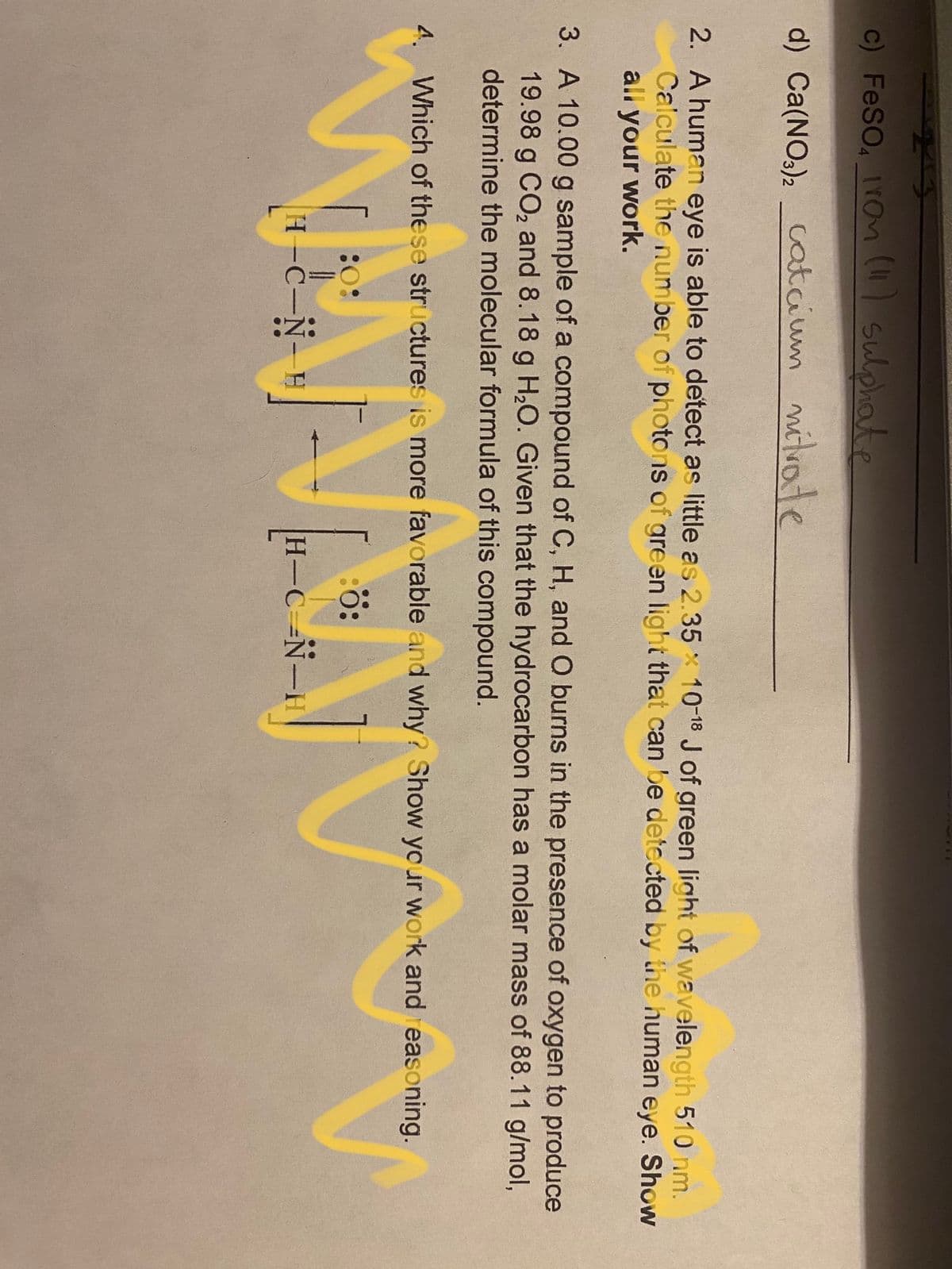3. A 10.00 g sample of a compound of C, H, and O burns in the presence of oxygen to produce has a molar mass of 88.11 g/mol, 19.98 g CO₂ and 8.18 g H₂O. Given that the hydrocarbon determine the molecular formula of this compound.
3. A 10.00 g sample of a compound of C, H, and O burns in the presence of oxygen to produce has a molar mass of 88.11 g/mol, 19.98 g CO₂ and 8.18 g H₂O. Given that the hydrocarbon determine the molecular formula of this compound.
Chemistry
10th Edition
ISBN:9781305957404
Author:Steven S. Zumdahl, Susan A. Zumdahl, Donald J. DeCoste
Publisher:Steven S. Zumdahl, Susan A. Zumdahl, Donald J. DeCoste
Chapter7: Atomic Structure And Periodicity
Section: Chapter Questions
Problem 137E: Cesium was discovered in natural mineral waters in 1860 by R. W. Bunsen and G. R. Kirchhoff, using...
Related questions
Question
Determine molecular formula of a compound.

Transcribed Image Text:c) FeSO, Iron (11) Sulphate
d) Ca(NO3)2 catcium nitrate
2. A human eye is able to detect as little as 2.35 x 10-18 J of green light of wavelength 510 nm.
Calculate the number of photons of green light that can be detected by the human eye. Show
all your work.
3. A 10.00 g sample of a compound of C, H, and O burns in the presence of oxygen to produce
19.98 g CO₂ and 8.18 g H₂O. Given that the hydrocarbon has a molar mass of 88.11 g/mol,
determine the molecular formula of this compound.
favorable and why? Show your work and reasoning.
:Ö:
H
H-C-N-H
4. Which of these structures is more
AV
:0:
H-C-N-H
Expert Solution
This question has been solved!
Explore an expertly crafted, step-by-step solution for a thorough understanding of key concepts.
This is a popular solution!
Trending now
This is a popular solution!
Step by step
Solved in 3 steps with 3 images

Knowledge Booster
Learn more about
Need a deep-dive on the concept behind this application? Look no further. Learn more about this topic, chemistry and related others by exploring similar questions and additional content below.Recommended textbooks for you

Chemistry
Chemistry
ISBN:
9781305957404
Author:
Steven S. Zumdahl, Susan A. Zumdahl, Donald J. DeCoste
Publisher:
Cengage Learning


Chemistry: An Atoms First Approach
Chemistry
ISBN:
9781305079243
Author:
Steven S. Zumdahl, Susan A. Zumdahl
Publisher:
Cengage Learning

Chemistry
Chemistry
ISBN:
9781305957404
Author:
Steven S. Zumdahl, Susan A. Zumdahl, Donald J. DeCoste
Publisher:
Cengage Learning


Chemistry: An Atoms First Approach
Chemistry
ISBN:
9781305079243
Author:
Steven S. Zumdahl, Susan A. Zumdahl
Publisher:
Cengage Learning

Chemistry: Principles and Practice
Chemistry
ISBN:
9780534420123
Author:
Daniel L. Reger, Scott R. Goode, David W. Ball, Edward Mercer
Publisher:
Cengage Learning

Chemistry & Chemical Reactivity
Chemistry
ISBN:
9781133949640
Author:
John C. Kotz, Paul M. Treichel, John Townsend, David Treichel
Publisher:
Cengage Learning

Chemistry & Chemical Reactivity
Chemistry
ISBN:
9781337399074
Author:
John C. Kotz, Paul M. Treichel, John Townsend, David Treichel
Publisher:
Cengage Learning